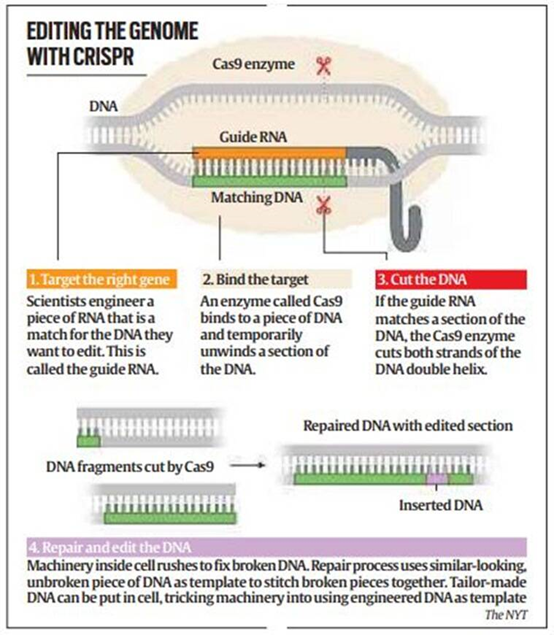

14th September 2022 (9 Topics)
Context
The gene-editing technology known as CRISPR, which turned 10 years old this year, has led to innovations in medicine, evolution and agriculture
About
What is CRISPR technology?
- CRISPR stands for Clustered Regularly Interspaced Short Palindromic Repeats.
- It is a reference to the clustered and repetitive sequences of DNA found in bacteria, whose natural mechanism to fight some viral diseases is replicated in this gene-editing tool.
|
Genetic Engineering:
|
- CRISPR is simple and still far more accurate and it does not involve the introduction of any new gene from the outside.
- Its mechanism is often compared to the ‘cut-copy-paste’, or ‘find-replace’ functionalities in common computer programmes.
- A bad stretch in the DNA sequence, which is the cause of disease or disorder, is located, cut, and removed and then replaced with a ‘correct’ sequence.
- The tools used to achieve this are not mechanical, but biochemical specific protein and RNA molecules.
- The technology replicates a natural defence mechanism in some bacteria that uses a similar method to protect itself from virus attacks.
|
Do You Know?
|

Why is it called a revolution?
- Improved quality of life: CRISPR has begun to deliver on the near unlimited potential to improve the quality of human life.
- Correcting genes: The technology enables a simple but remarkably efficient way to ‘edit’ the genetic codes of living organisms, thus opening up the possibility of ‘correcting’ genetic information to cure diseases, prevent physical deformities, or to even produce cosmetic enhancements.
- The first task is to identify the particular sequence of genes that is the cause of the trouble. Once that is done, an RNA molecule is programmed to locate this sequence on the DNA strand.
- After this, a special protein called Cas9, which is often described as ‘genetic scissors’, is used to break the DNA strand at specific points, and remove the bad sequence.
CRISPR-Cas9
- CRISPR-Cas9 is the most common, cheap and efficient system used for genome editing.
- CRISPR stands for ‘clustered regularly interspaced short palindromic repeats’.
- CRISPR is the DNA-targeting part of the system which consists of an RNA molecule, or ‘guide’, designed to bind to specific DNA bases through complementary base-pairing.
- Cas9 stands for CRISPR-associated protein 9, and is the nuclease part that cuts the DNA.
- The CRISPR-Cas9 system was originally discovered in bacteria that use this system to destroy invading viruses.

|
Deoxyribonucleic acid (DNA):
|



